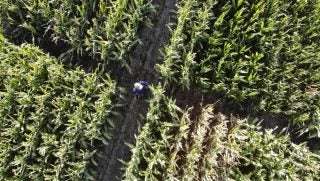It’s bulls and blood
It’s dust and mud
It’s the roar of a Sunday crowd
Or so says Garth Brooks.
More often than not, as sung about on country radio by the likes of Brooks, the heritage and tradition of rodeo is painted as the quintessential cowboy life. The aw-shucks-All-American-George-Strait-types who work day in and day out, eeking a living underneath those Western skies, is ingrained in the history of rodeo. And while most certainly those types are plentiful, like all things American, the backstory about the world of rodeo is a little more complex than what meets the eye.
This sport, and the story behind it, is a blend of cultures, traditions, and upbringings all melded into this one thing they call the rodeo.
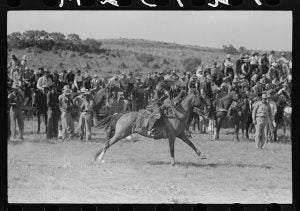
Spanish Origins
The roots of today’s rodeo culture reach way back to the cattle industry of the American West, where it was originally influenced by Spanish conquistadors in the 1700s. There, rodeo inherited many of its practices from Spanish ranchers and their Mexican ranch hands, known as vaqueros. The word “rodeo” itself is derived from the Spanish word “rodear” meaning “roundup,” in reference to the roundup of cattle.
As pioneers from the East interacted with the Spanish, Mexican, Californian, and Texan cowboys, they inevitably picked up many of the vaqueros’ styles and traditions of working the ranch.
The blending of Anglo and Spanish-Mexican cultures led to the birth of the American cowboy era in the 1800s. Breaking horses to ride and catching cattle for branding, medical attention, and sale required roping and riding skills on the frontier ranches. In the 1820s and ’30s friendly ranch-versus-ranch contests began to spring up with cowboys and vaqueros testing their skills against each other.
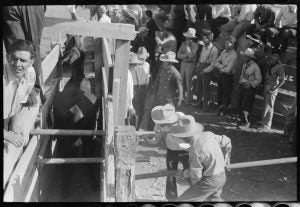
The Cowboy Era
It wasn’t until after the Civil War, however, that the cowboy era truly began, as ranchers from the Southwest organized cattle drives to deliver cattle to trains where they would then be transported East. In their free time at the end of a drive, cowboys would hold informal competitions against each other to see which group had the best skills in riding and roping. These gatherings soon translated into competitions on display at race tracks, fairgrounds, and festivals across the West. From these initial contests, modern rodeo would eventually be born. And many of the skills showcased evolved into today’s tie-down roping, team roping, steer roping, and bronc riding events.
As the railroad expanded and fencing was introduced to the West, this brought an end to the open range and left many cowboys without regular employment. With only seasonal work available, they began to participate in cowboy entertainment programs that were being established. Social occasions, like the Fourth of July, provided cowboys the chance to challenge the bronc riding and roping skills of cowboys from other ranches, and these contests soon became annual events.
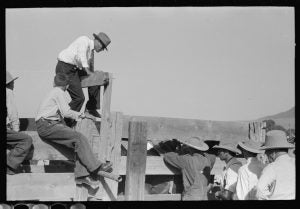
The First Rodeo
Some allege that the first official rodeo was born in 1869 in Deer Trail, Colorado, when two groups of cowboys from neighboring ranches met to settle an argument over who was best at performing everyday cowboy tasks, including breaking wild horses, which is today’s saddle bronc riding event.
While many consider this event to be the first rodeo, over the years, a culmination of skills and techniques from Spanish-speaking cowboys, vaqueros, and cowboys from the East combined to bring us today’s modern rodeo.
Many others claim to be the first rodeo in the U.S., including Cheyenne, Wyoming, in 1872; Winfield, Kansas, in 1882; and Pecos, Texas, in 1883. Still, these early contests were primarily simple displays of riding and roping skills and not the organized events now standard in today’s rodeo industry.
From the 1880s through the 1920s, frontier days, stampedes, and cowboy contests were the most popular names of what we now call the rodeo. Buffalo Bill Cody and his Fourth of July Wild West show in North Platte, Nebraska, in 1882 was the first competition to offer prize money, with Prescott, Arizona, claiming to hold the “first formalized rodeo” on July 4, 1888. From there, Cheyenne Frontier Days in 1897, the Pendleton Round-Up in 1910, and the Calgary Stampede in 1912 followed as popular rodeo venues.
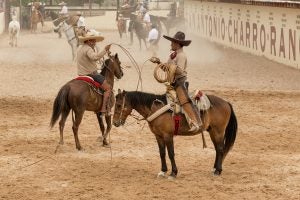
A Sport for All
Initially, rodeo was a fairly nondiscriminatory sport, often including Hispanic, African American, Native American, and female contestants in an era when race and gender discrimination were commonplace. Women competed in many events at mixed-gender rodeos well into the 1930s. During this time, ladies often competed against men and won in a variety of rodeo events, including bronc riding and steer roping, as well as trick and fancy roping and riding.
One of the more well-known female competitors was Phoebe Ann Moses Butler. Butler grew up in a poor family in Ohio, where she took up hunting to provide for her family after her father died. From those marksman skills developed as a hunter, she earned the nickname “Little Sure Shot” and joined Buffalo Bill Cody’s Wild West Show as Annie Oakley in 1885.
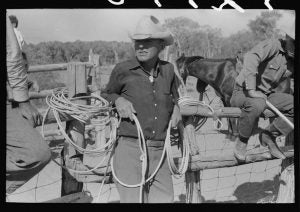
Rules Changing
In 1929, two events occurred that changed the course of rodeo history:
- Well-known cowgirl Bonnie McCarroll died in a bronc riding accident at Pendleton, Oregon, leading many rodeos to drop women’s contests.
- That same year, the Rodeo Association of America was formed in an effort to bring organization and structure to the chaotic contest. It was established by rodeo organizers, and not the cowboys themselves, to standardize rules, establish a point system, monitor judges, and establish fair prize money. In large part because of McCarroll’s death, the RAA was organized as an all-male entity.
On October 30, 1936, cowboys and cowgirls boycotted the rodeo in Madison Square Gardens in order to demand better prize money and judges who understood rodeo. The cowboys organized the Cowboys Turtle Association on November 6, 1939 — a name they picked because they had been slow to act, but had finally stuck their necks out for their cause. In 1945, the Turtles became the Rodeo Cowboys Association (RCA), which evolved into the Professional Rodeo Cowboys Association (PRCA) in 1975.
1945 marks the year professional cowboys officially adopted the term “rodeo” for their sport. The PRCA went on to sanction the events and rules for saddle bronc riding, bareback riding, bull riding, calf roping, steer wrestling, team roping, and single steer roping.
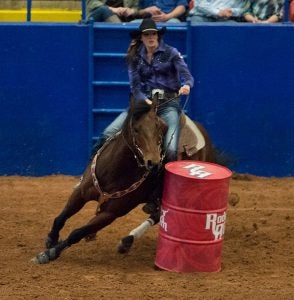
Women Rally
When Gene Autry created his own rodeo company in the early 1940s, one of his first actions was to discontinue the cowgirl bronc riding contest. With that event gone, there was little left for the cowgirls to participate in except the invitation-only sponsor girl event. Soon, cowgirl contests disappeared from rodeos nationwide.
However, it was these first sponsor contests that led to today’s barrel racing.
Women realized it would be up to them to get back into the mainstream of the sport and in 1948, the Girl’s Rodeo Association, now the Women’s Professional Rodeo Association (WPRA), was started by a group of Texas ranch women. The WPRA was highly successful in restoring cowgirl contests to PRCA rodeos. Barrel racing was the most popular WPRA contest, and it spread rapidly throughout the country. It is now the only women’s event standard at PRCA rodeos and often ranks second only to bull riding in popularity.
If not for the McCarroll tragedy and Gene Autrey, it is unlikely there would ever have been a need for the WPRA, and barrel racing would probably not exist.
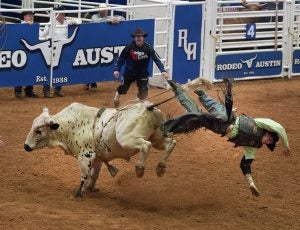
Today’s Rodeo
Today’s National Finals Rodeo (NFR), organized by the PRCA, is the premier championship rodeo event and is held the first full week of December each year in Las Vegas. In addition to barrel racing, the rodeo consists of bareback riding, steer wrestling, team roping, saddle-bronc riding, tie-down roping, and bull riding.
Bull Riding
The most popular event in the sport of rodeo is bull riding, hands down. In a twist of tradition stemming from bronc riding, bull riding initially began in the 1910s — but it wasn’t until the 1930s that the larger Brahman and crossbred bulls became the norm.
The bull riding event involves a bull weighing in the realm of a ton being ridden by a cowboy using a flat-braided rope to hang on for eight seconds while his other hand remains free. If he touches the bull, the rope, or himself with the free hand he is disqualified. The cowboy is judged not only for his ability to stay on the bull, but for his ability to ride the bull well (staying balanced, staying in control, and being able to spur the bull) as well as the bull’s power, agility, and bucking motion.
Bronc Riding
Bronc riding was derived from the necessity of breaking and training wild horses on the frontier and today has two different events in modern rodeo: bareback and saddle.
Bareback cowboys ride the horses without saddle or rein and ride while holding onto a leather rigging with one hand. While a bareback rider has a rigging to hold onto, the saddle bronc rider has only a thick rein attached to his horse’s halter. Both events last for eight seconds and cowboys are judged on their ability to stay in control as well as their spurring technique. The horses are judged as well, with saddle broncs typically being several hundred pounds heavier than bareback horses and generally bucking in a slower manner.
Calf Roping
Calf roping is generally referred to today as tie-down roping and is another event evolved from frontier life where calves needed to be caught and secured for branding and doctoring.
In today’s rodeo, a cowboy is timed as he attempts to rope a 250- to 350-pound calf from the back of a horse while simultaneously bringing his horse to an abrupt stop, consequently stopping the calf. The horse keeps the rope pulled tight while the cowboy dismounts, runs to the calf, throws it on its side, and ties three legs. Time is called after the cowboy throws up his or her hands after the tie-down, and the calf must stay tied for six seconds in order for the time to be qualified.
Team Roping
The main difference between the purpose of calf roping and team roping is the size of the cattle being roped. Team ropers work together because the steers they need to catch are often too big for one person.
The first roper, the “header,” catches the steer by the horns and secures the rope around the saddle horn and changes the direction of the steer. Meanwhile, the second roper, the “heeler,” ropes the steer’s back feet and secures the rope around the saddle horn while stopping the horse. The event is scored based on time and was another essential skill for the original cowboy.
Steer Wrestling
Steer wrestling, also called bulldogging, is the one rodeo contest never actually practiced on the range. Bull wrestling has been known to be part of ancient traditions throughout the Mediterranean world, including Spain, and is said to have originated with Mexican contests where the cowboy would ride up behind the steer, grab its tail, and twist the steer to the ground.
The American rodeo derived its own version of steer wrestling from Black cowboy Bill Pickett, who created a different method of bulldogging steers. He would jump from his horse onto a steer’s back, biting its upper lip, and throwing it to the ground by grabbing its horns. This is the only rodeo event that can be attributed to a single individual. Today, cowboys no longer bite the steer’s upper lip, but the rest of the event remains the same, with the prize being given to the cowboy who can get the steer to the ground the quickest.
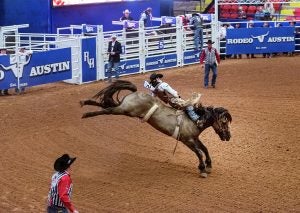
If you get the chance to attend one of many rodeos held all around our nation on any given Friday, Saturday, or Sunday, it truly is like Garth Brooks says:
It’s boots and chaps
It’s cowboy hats
It’s spurs and latigo
It’s the ropes and the reins
And the joy and the pain
And they call the thing rodeo
But now you know those skills, techniques, and traditions aren’t just for the Anglo-Cowboy, but also for the cowgirl, the Spanish, the African American, the Native American, and all others whose cultures blended to make this great thing we call the rodeo.
Katie Murray is a lifelong promoter of agriculture and lover of good stories. She enjoys communicating the story of agriculture and of the people behind our industry.

